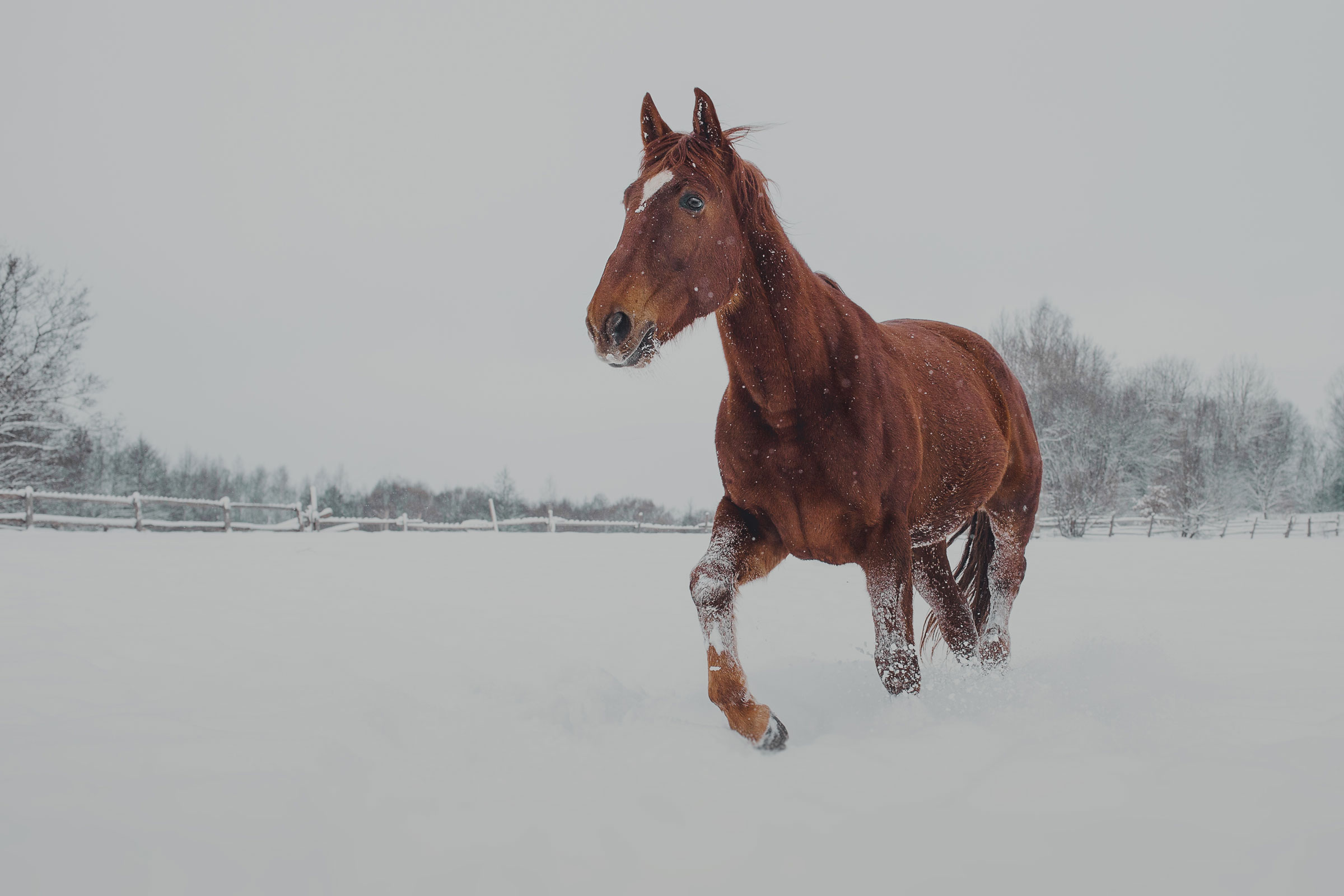
Anyone who actually experiences winter on a horse farm can face snow, ice and mud. In this article we offer some tips to help you avoid problems in the winter.
To Shoe or Not to Shoe?
You might be one of those folks who scratches his or her head each winter trying to decide whether to keep your horse in shoes or not. Different parts of the country experience varying degrees of tricky winter footing. The serene landscape of recent snowfall takes on a different dimension when it comes to winter riding safety. Snow comes in all types of moisture content ranging from dry and fluffy that easily scatters, to wet enough to pack into ice balls when compressed under a horse’s hooves.
Regardless of whether there is slippery terrain or not, it is often difficult to find time to ride during the winter due to shortened hours of daylight. One practical winter strategy has your farrier pull your horse’s shoes and leave them off for a couple of months. Going barefoot allows the hooves to “rest” from the shoes and achieve a more natural, expansible state. Winter is an opportune time to do this. On the other hand, some horses have particularly thin soles or fragile hooves that become sore when left barefoot. You’ll want to customize a strategy according to your horse’s unique needs.
Barefoot Option
With snow on the ground, a barefoot horse might get along fine. An important feature of leaving a horse barefoot is the ability to shed ice and snow balls that collect in the feet during periods of snow and with freezing and thawing of the snow and ground.
Yet, for extended periods when the ground remains bare of snow, you might want to pursue options for hoof protection by using hoof boots. A variety of boots on the market are designed to keep the hoof capsule from excess wear while also protecting a horse’s soles from bruising. The boots are easily applied and removed. Check that all straps and Velcro tabs are functional.
Barefoot or not, you’ll want to arrange a regular trimming schedule with your farrier. The frequency is determined by how much snow cover remains, how much your horse moves around to wear his hooves, and how quickly his feet tend to grow. The interval between winter trims might lengthen as compared to spring and summer, especially when the horse is unshod. The objective is to find a trim schedule that keeps your horse’s hooves as strong and aligned as possible so he’ll be ready to go back to work once spring arrives.
Shod Option
If you do keep your horse in shoes during the winter, there are techniques that can reduce his risk of slippage on snow and ice. Discuss with your farrier whether snow-popping “bubble” pads or anti-snowball rim pads are appropriate. The rim pad forms a “gasket” around the inside edge of the horseshoe, thereby limiting the stick of snow or ice on cold steel; the pop pad limits how much snow can pack up within the sole area to form ice balls.
Caulks, metal studs or hard-surfacing tungsten grit—often referred to as “borium”—added to the ground surface of the shoes are known to improve traction on slippery terrain. In some cases, these traction devices applied to the horseshoes are helpful for ice encounters, but they can be hazardous to limb structures when used over dry ground. There is a significant trade-off to using traction devices since not all ground is slippery at all times. A foot might stick as the traction devices stick on non-slippery ground, which is a problem as a horse’s huge bulk continues moving forward despite one or more legs remaining “planted.” Ground-grabbing caulks or studs can cause an unwelcome consequence of injury to a joint, tendon or ligament.
Studs are sharp and abrasive, and if a horse hits one of his other legs with the stud or snags his blanket strap when lying down, there could be significant injury.
Sometimes, the best advice is to avoid caulks or studs altogether. Either keep your horse barefoot, and/or don’t ride a shod horse on slippery terrain. Even if the going might be slow, it is best to be cautionary. Walking exercise on trails is always good in the winter when possible, but always keeping safety in mind.
Mud
In periods of significant rain you might find that paddocks, pastures and trails often turn into a quagmire of mud. Mud poses its own challenges to horse safety. It can cause slippage of one or more limbs, and even falls. Thick mud can “entrap” a foot, with a moving horse incurring injuries similar to those mentioned above for traction devices. And, mud is notorious for sucking off even the best-affixed horseshoes.
Unless your horse is conditioned to deep footing, it is best to refrain from riding in those conditions and you might even consider not turning your horse out into muddy areas.
Turning Out in Bad Weather
While turnout is ideal for a horse’s general health, turnout in questionable winter footing or during a mid-winter thaw in mud is not always a safe bet. Ground that is frozen into ruts formed by hoof prints or vehicle traffic can cause a horse to twist a leg, leading to potentially calamitous musculoskeletal injuries. Mud presents risks of musculoskeletal problems as mentioned above.
Another common winter concern occurs when snow thaws and refreezes, often turning into glare ice; this increases the risk of limb fractures legs and pelvic injuries due to slipping and falls. At times when traction is at a minimum, it’s best to keep horses in a safe, dry area until conditions improve enough to allow for turnout.


